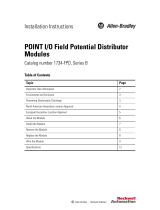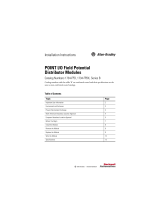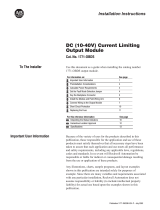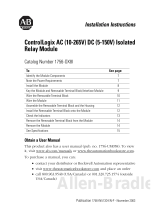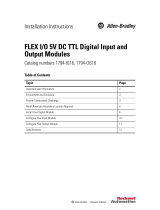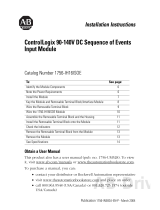La page est en cours de chargement...

+" * %$ ++)*
Cat. No. 1771-ID16 Series B
Use this document as a guide when installing the ac Isolated Input
module.
$(" $%(#* %$
#&%(*$* )( $%(#* %$
$ * " $" $
"+"* &%,( ('+ (#$*)
* * "*( * #
- * !&"$ %$$*%(
$)*"" * #%+" $ " , ( $ (#
%$$* * , ( $ *% * #%+"
$*(&(* * )**+) $ *%()
.(%+) %* %$)
& * %$)
This module must be used in a series B or later 1771 I/O chassis. The
1771-ID16 is not compatible with the 1771-AL local I/O adapter.
This module contains customer-selectable input filtering to limit the
effects of voltage transients caused by contact bounce and/or radiated
electrical noise. The delay due to filtering is 9.0 or 18.0ms for
turning ac inputs on to off, and 0.57ms for turning ac inputs off to
on: 9.0ms for turning dc inputs on to off, and 0.57ms for turning dc
inputs off to on. The filter time is factory set to 9.0ms.
The module is designed to operate with limit switches, float
switches, selector switches, and pushbutton switches.
Installation Instructions

ac/dc (120V) Isolated Input Module2
Because of the variety of uses for the products described in this
publication, those responsible for the application and use of these
products must satisfy themselves that all necessary steps have been
taken to assure that each application and use meets all performance
and safety requirements, including any applicable laws, regulations,
codes and standards. In no event will Rockwell Automation be
responsible or liable for indirect or consequential damage resulting
from the use or application of these products.
Any illustrations, charts, sample programs, and layout examples
shown in this publication are intended solely for purposes of
example. Since there are many variables and requirements associated
with any particular installation, Rockwell Automation does not
assume responsibility or liability (to include intellectual property
liability) for actual use based upon the examples shown in this
publication.
Allen–Bradley publication SGI–1.1, Safety Guidelines for
Application, Installation, and Maintenance of Solid–State Control
(available from your local Rockwell Automation office), describes
some important differences between solid–state equipment and
electromechanical devices that should be taken into consideration
when applying products such as those described in this publication.
Reproduction of the contents of this copyrighted publication, in
whole or part, without written permission of Rockwell Automation,
is prohibited.
Throughout this publication, notes may be used to make you aware
of safety considerations. The following annotations and their
accompanying statements help you to identify a potential hazard,
avoid a potential hazard, and recognize the consequences of a
potential hazard.
WARNING
!
Identifies information about practices or
circumstances that can cause an explosion in a
hazardous environment, which may lead to
personal injury or death, property damage, or
economic loss.
ATTENTION
!
Identifies information about practices or
circumstances that may lead to personal injury or
death, property damage, or economic loss.

ac/dc (120V) Isolated Input Module 3
IMPORTANT
Identifies information that is critical for
successful application and understanding of the
product.
ATTENTION
!
This equipment is intended for use in a Pollution
Degree 2 industrial environment, in overvoltage
Category II applications (as defined in IEC
publication 60664–1), at altitudes up to 2000
meters without derating.
This equipment is considered Group 1, Class A
industrial equipment according to IEC/CISPR
Publication 11. Without appropriate precautions,
there may be potential difficulties ensuring
electromagnetic compatibility in other
environments due to conducted as well as radiated
disturbance.
This equipment is supplied as “open type”
equipment. It must be mounted within an
enclosure that is suitably designed for those
specific environmental conditions that will be
present, and appropriately designed to prevent
personal injury resulting from accessibility to live
parts. The interior of the enclosure must be
accessible only by the use of a tool. Subsequent
sections of this publication may contain additional
information regarding specific enclosure type
ratings that are required to comply with certain
product safety certifications.
See NEMA Standards publication 250 and IEC
publication 60529, as applicable, for explanations
of the degrees of protection provided by different
types of enclosures. Also, see the appropriate
sections in this publication, as well as the
Allen–Bradley publication 1770–4.1, (“Industrial
Automation Wiring and Grounding Guidelines”),
for additional installation requirements pertaining
to this equipment.

ac/dc (120V) Isolated Input Module4
The isolated input module is shipped in a static-shielded packaging
to guard against electrostatic discharge damage. Observe the
following precautions when handling the module.
!
ATTENTION
Preventing Electrostatic Discharge
This equipment is sensitive to electrostatic
discharge, which can cause internal damage and
affect normal operation. Follow these guidelines
when you handle this equipment:
• Touch a grounded object to discharge potential
static.
• Wear an approved grounding wriststrap.
• Do not touch connectors or pins on component
boards.
• Do not touch circuit components inside the
equipment.
• If available, use a static–safe workstation.
• When not in use, keep modules in appropriate
static–safe packaging.
Your module receives its power through the 1771 I/O chassis
backplane from the chassis power supply. The module requires
75mA from the output of this supply. Add this to the requirements of
all other modules in the I/O chassis to prevent overloading the
chassis backplane and/or backplane power supply.
The input module has 2 customer-selectable input filter time
jumpers. Jumper JPR 1 sets the input filter time for inputs 00 through
07, and jumper JPR 2 sets the input filter time for inputs 10 through
17. These filter times apply when the input is cycling from ON to
OFF. The OFF to ON filter time is fixed at 0.57ms. Refer to Table A
for filter times and jumper settings.
IMPORTANT
Half cycle dropout protection is dependent upon
the position of the jumpers. With the jumpers at
the 9.0ms position (Fast), half cycle protection
may not be guaranteed. If half cycle dropout
protection is required, position the jumpers in
the 18.0ms position (Norm). Maximum and
minimum filter times are shown in Table A.
Initial Handling
Calculate Power
Requirements
Set the Filter Time

Filter Time Jumpers
E1 = Jumper for inputs 00 through 07
E2 = Jumper for inputs 10 through 17
NORM
NORM
FAST
FAST
CH0-7
CH10-17
E1
E2
10557ĆI
ac/dc (120V) Isolated Input Module 5
Publication 1771-IN070B-EN-P - August 2002
To set the filtering time, proceed as follows:
1. Remove the side covers from the module circuit board by
removing the four screws securing the covers to the module and
remove the circuit board.
2. Position the jumpers as required to provide the filter time you
require (see below). Use your fingers to pull the jumper up and
position over the 2 pins corresponding to your selection (Fast or
Norm).
Setting the Filter Time Jumpers
Jumper Position Time Constant (ms)
Fast (factory default) 9.0 (ac/dc)
Norm 18.0 (ac only)
3. Reinstall the covers on the module circuit board and secure with 4
screws.
Table A
Minimum and Maximum Filter Times
Input
Voltage
Filter Time
(msec)
Off to On (ms)
Minimum Maximum Typical
On to Off (ms)
Minimum Maximum Typical
ac 9.0 0.5 7.0 2.0 7.0 33 20
ac 18.0 0.5 8.1 2.0 14.0 42 29
dc 9.0 0.7 2.2 1.3 8.3 25 13

ac/dc (120V) Isolated Input Module6
'&! ''%&
Key the Backplane Connector
Place your module in any slot in the chassis
except the leftmost slot which is reserved for
processors or adapters.
Observe the following precautions
when inserting or removing keys:
• insert or remove keys with your
fingers
• make sure that key placement is
correct
Incorrect keying or the use of a tool
can result in damage to the
backplane connector and possible
system faults.
!
ATTENTION
!%&! & ) % & " ! &!$% &! !$$%"! &!
& ) %!&% ! & !'
& ) %
&( 22 24
&( 26 28
!' & "!%&! ! &% %
%'%#' & %)%& % $($ %
%$&! ! $ & &)" ! !' %%$)
""$ ! &!$
*
%%%
!
ATTENTION
Remove power from the 1771 I/O chassis
backplane before you install the module. Failure
to remove power from the backplane could cause:
• module damage
• degradation of performance
• injury or equipment damage due to possible
unexpected operation
!
WARNING
When you insert or remove the module with field
power applied, or connect or disconnect the field
wiring arm with field side power applied, an
electrical arc can occur. This could cause an
explosion in hazardous location installations.Be
sure that power is removed or the area is
nonhazardous before proceeding.
Install the Module and Field
Wiring Arm

ac/dc (120V) Isolated Input Module 7
Publication 1771-IN070B-EN-P - August 2002
Swing the chassis locking bar down into place to secure
the modules. Make sure the locking pins engage.
1771ĆA1B, ĆA2B, ĆA3B, ĆA3B1, ĆA4B I/O chassis
1771ĆA1B, ĆA2B, ĆA3B1, ĆA4B Series B I/O chassis
locking tab
card guides
Module
Module
19809
card guides
locking bar
locking bar pin
Snap the chassis latch over
the top of the module to secure it.
17643
wiring arm
remove
horizontal bar
Attach the wiring arm (1771ĆWN) to the horizontal
bar at the bottom of the I/O chassis.
The wiring arm pivots upward and connects with
the module so you can install or remove the
module without disconnecting the wires.
1771ĆWN
The 1771–ID16/B module is a modular component of the 1771 I/O
system requiring a properly installed system chassis. Refer to
publication 1771–IN075 for detailed information on acceptable
chassis, proper installation and grounding requirements. Limit the
maximum adjacent slot power dissipation to 10W maximum.

ac/dc (120V) Isolated Input Module8
Connections to the input module are made to the 40 terminal field
wiring arm (cat. no. 1771-WN) shipped with the module. Attach the
wiring arm to the pivot bar on the bottom of the I/O chassis. The
wiring arm pivots upward and connects with the module so you can
install or remove the module without disconnecting the wires.
1. Make certain all power is removed from the module before
making wiring connections.
2. Swing the wiring arm up into position on the front of the module.
The locking tab on the module will secure it into place.
!
WARNING
When you connect or disconnect the field wiring
arm with field power applied, or remove the
module while backplane power is on, an electrical
arc can occur. This could cause an explosion in
hazardous location installations.
Be sure that power is removed or the area is
nonhazardous before proceeding.
!
ATTENTION
Remove power from the 1771 I/O chassis
backplane and field wiring arm before removing
or installing an I/O module.
• Failure to remove power from the backplane or
wiring arm could cause module damage,
degradation of performance, or injury.
• Failure to remove power from the backplane
could cause injury or equipment damage due to
possible unexpected operation.
3. Make your connections to the field wiring arm as shown in the
following figure. (Use the label on the front of the wiring arm to
identify your wiring.)
Note: A shorting bar may be used to connect the commons if
channel-to-channel isolation is not required.
IMPORTANT
The field wiring arm terminal identification
number is not the same as the number of the bit
which controls that output.

ac/dc (120V) Isolated Input Module 9
+#"*"&% + +)*
Figure 1
Connection Diagram for the 1771ĆID16 ac/dc (120V) Isolated Input
Module
%'+*
%'+*
%'+*
%'+*
%'+*
%'+*
%'+*
%'+*
%'+*
%'+*
%'+*
%'+*
%'+*
%'+*
%'+*
%'+*
" !
&,
.
.
.
.
.
.
.
.
.
.
.
.
.
.
.
.
&* )
&* +)
&* +)
&* +)
&* +)
&* +)
&* +)
&* +)
+''#-
*+# ,"("% (+%) "% *!") "(*"&%
&,
ac Input
%'+*
%'+*
%'+*
%'+*
%'+*
%'+*
%'+*
%'+*
%'+*
%'+*
%'+*
%'+*
%'+*
%'+*
%'+*
%'+*
&$$&%
.
.
.
.
.
.
.
.
.
.
.
.
.
.
.
.
&* )
&* +)
&* +)
&* +)
&* +)
&* +)
&* +)
&* +)
+''#-
*+# ,"("% (+%) "% *!") "(*"&%
dc Input
!
ATTENTION
Maintain isolation between phases to prevent
module damage.

ac/dc (120V) Isolated Input Module10
Publication 1771-IN070B-EN-P - August 2002
IMPORTANT
You can use an ac (120V) output module (cat.
no. 1771-OA, 1771-OD or 1771-OP) to directly
drive terminals on an ac/dc (120V) input module
(cat. no. 1771-ID16), but you must use a 2.5K,
10W resistor between the output terminal and
L2 (common) as shown in the following figure.
AC/DC (120V)
Isolated Input Module
(Cat. No. 1771-ID16)
L1
ac high
10559-I
2
4
6
8
10
12
14
16
18
20
22
24
26
28
30
32
34
36
38
40
2
4
6
8
10
12
14
16
18
20
22
24
26
28
30
32
34
36
38
40
AC (120V)
Isolated Output Module
(Cat. No. 1771-OD16)
120V ac
SupplyL2
ac low
AC/DC (120V)
Isolated Input Module
(Cat. No. 1771-ID16)
2
4
6
8
10
12
14
16
18
20
22
24
26
28
30
32
34
36
38
40
A
O
1
2
3
4
5
6
7
B
L2
ac low
L1
ac high
AC (120V) Output Module
(Cat. No. 1771-OA)
Actual wiring runs in this direction.
Resistor Typically
2.5K Ohms 10W
!
ATTENTION
Maintain isolation between phases to prevent
module damage.

ac/dc (120V) Isolated Input Module 11
%$ %%#$
The module has 17 indicators (below), consisting of 16 input status
indicators and an active indicator. The 16 status indicators will light
when the field load has been applied to the field wiring arm of the
module.
!%$ $$ $ "#
"
$ "
"
&
The active indicator will light when the module has successfully
started up and has initialized.

ac/dc (120V) Isolated Input Module12
Publication 1771-IN070B-EN-P - August 2002
The following information applies when operating this equipment in
hazardous locations:
Products marked CL I, DIV 2, GP A, B, C, D" are suitable for use in Class I Division 2
Groups A, B, C, and D Hazardous Locations and nonhazardous locations only. Each
product is supplied with markings on the rating nameplate indicating the hazardous location
temperature code. When combining products within a system, the most adverse
temperature code (lowest T" number) may be used to help determine the overall
temperature code of the system. Combinations of equipment in your system are subject to
investigation by the local Authority Having Jurisdiction at the time of installation.
!
WARNING
EXPLOSION HAZARD -
• Do not disconnect equipment unless power has been removed
or the area is known to be nonhazardous.
• Do not disconnect connections to this equipment unless power
has been removed or the area is known to be nonhazardous.
Secure any external connections that mate to this equipment
by using screws, sliding latches, threaded connectors, or other
means provided with this product.
• Substitution of components may impair suitability for Class I,
Division 2.
• If this product contains batteries, they must only be changed in
an area known to be nonhazardous.
Informations sur l'utilisation de cet équipement en environnements dangereux
:
Les produits marqués CL I, DIV 2, GP A, B, C, D ne conviennent que une utilisation en
environnements de Classe I Division 2 Groupes A, B, C, D dangereux et non dangereux.
Chaque produit est livré avec des marquages sur sa plaque d'identification qui indiquent le
code de température pour les environnements dangereux. Lorsque plusieurs produits sont
combinés dans un systéme, le code de température le plus défavorable (code de
température le plus faible) peut eatre utilisé pour déterminer le code de température global
du systéme. Les combinaisons d'equipements dans le systéme sont sujettes à inspection
par les autorités locales qualifiées au moment de l'installation.
!
AVERTISSEMENT
RISQUE D'EXPLOSION -
• Couper le courant ou s'assurer que l'environnement est classé
non dangereux avant de débrancher l'équipement.
• Couper le courant ou s'assurer que l'environnement est classé
non dangereux avant de débrancher les connecteurs. Fixer
tous les connecteurs externes reliés à cet équipement à l'aide
de vis, loquets coulissants, connecteurs filetés ou autres
moyens fournis avec ce produit.
• La substitution de composants peut rendre cet équipement
inadapté à une utilisation en environnement de Classe 1,
Division 2.
• S'assurer que l'environnement est classé non dangereux avant
de changer les piles.

ac/dc (120V) Isolated Input Module 13
Publication 1771-IN070B-EN-P - August 2002
Inputs per Module1 16
Module Location 1771ĆA1B thru ĆA4B or later I/O chassis
1771-AM1, -AM2 Chassis
Input Voltage Range 74-138V ac, 47-63Hz; 105-138V dc
Nominal Input Voltage 120V ac/dc
Nominal Input Current 120V ac: 12.4mA @ 50Hz; 14.9mA @ 60Hz
120V dc: 2.5mA
On-state Voltage (minimum) 74V ac; 105V dc
On-state Current (minimum) 6.0mA @ 74V ac, 47-63Hz
1.2mA @ 105V dc
Off-state Voltage (maximum) 45V ac; 66V dc
Off-state Current (minimum) 4.0mA @ 45V ac, 47-63Hz; 0.8mA @ 66V dc
Input Signal Delay
OfftoOn
On to Off
0.57ms for ac; 0.57ms for dc
Selectable: 9ms or 18.0ms for ac; Fixed; 9ms for dc
Input Impedance (minimum) ac: 9.3K ohms @ 47Hz; 6.9K ohms @ 63Hz
dc: 75K ohms off; 48K ohms on
Power Dissipation 7.0 Watts (max.), 0.3 Watts (min.)
Thermal Dissipation 23.8 BTU/hr (max.), 1.0 BTU/hr (min.)
Backplane Current 75mA maximum
Isolation Voltage Tested to 1500V ac channelĆtoĆchannel for 1s; 1500V ac channel to backplane
for 1s
Maximum Cable Length 1000ft (304.8m)
Conductors Wire Size
Category
Only 14 to 22 gauge (2.5mm
2
to 0.25mm
2
) stranded or solid copper rated at
60
o
or greater
1. 2
3/64 inch (1.2mm) insulation maximum
1
3
Environmental Conditions
Operating
Temperature
IEC 60068-2-1 (Test Ad, Operating Cold)
IEC 60068-2-2 (Test Bd, Operating Dry Heat)
IEC 60068-2-14 (Test Nb, Operating Thermal Shock)
32 to 140°F(0
o
to 60
o
C)
Storage Temperature IEC 60068-2-1 (Test Ab, Unpackaged, Nonoperating Cold)
IEC 60068-2-2 (Test Bb, Unpackaged, Nonoperating Dry Heat)
IEC 60068-2-14 (Test Na, Unpackaged, Nonoperating Thermal Shock)
-40 to 185°F (-40 to 85
o
C)
Relative Humidity IEC 60068-2-30 (Test Db, Unpackaged, Nonoperating Damp Heat)
5 to 95%, noncondensing
Shock
Operating
Nonoperating
IEC 60068-2-27 (Test Ea, Unpackaged Shock)
30g
50g
Vibration IEC 60068-2-6 (Test Fc, Operating)
2g @ 10-500Hz
ESD Immunity IEC 61000-4-2
4kV contact discharges
Radiated RF Immunity IEC 61000-4-3
10V/m with 1kHz sine-wave 80% AM from 30MHz to 1000MHz
10V/m with 200Hz 50% pulse 100% AM at 900MHz

ac/dc (120V) Isolated Input Module14
Publication 1771-IN070B-EN-P - August 2002
EFT/B Immunity IEC 61000-4-4
+
1kV @ 5kHz on signal ports
Surge Transient Immunity IEC 61000-4-5
+
1kV line-line (DM) and +2kV line-earth (CM) on signal ports
Conducted RF Immunity IEC 61000-4-6
10V rms with 1kHz sine wave 80% AM from 150kHz to 30MHz
Emissions CISPR 11
Group 1, Class A (with appropriate enclosure)
Enclosure Type Rating None (open-style)
Keying Between 22 and 24
Between 26 and 28
Field Wiring Arm 1771ĆWN
Wiring Arm Screw Torque 9 pound-inches (1.0Nm)
Certifications
(when product is marked)
UL UL Listed Industrial Control Equipment
CSA CSA Certified Process Control Equipment
CSA CSA Certified Process Control Equipment for Class I,
Division 2 Group A, B, C, D Hazardous Locations
CE
4
European Union 89/336/EEC EMC Directive,
compliant with:
EN 61000-6-4, Industrial Emissions
EN 50082-2, Industrial Immunity
EN 61326, Meas./Control/Lab., Industrial Requirements
EN 61000-6-2, Industrial Immunity
European Union 73/23/EEC LVD Directive, compliant with:
EN 61131-2, Programmable Controllers
C-Tick
4
Australian Radiocommunications Act, compliant with:
AS/NZS 2064, Industrial Emissions
1
One or two 14-22 AWG solid or stranded copper wires per terminal. Must be same size. Do not intermix solid and stranded wires. Use
copper wire only
2
14 gauge wire connected to all terminals may not allow the field wiring arm cover to close. A smaller wire size may be required.
3
Refer to publication 1770Ć4.1, Industrial Automation Wiring and Grounding Guidelines."
4
See the Product Certification link at www.ab.com for Declarations of Conformity, Certificates and other certification details

ac/dc (120V) Isolated Input Module 15

Publication 1771ĆIN070B-EN-P - August 2002
Supersedes publication 1771Ć5.70 - November 1999
PN957707-56
Copyright 2002 Rockwell Automation, Inc. Printed in USA
/
